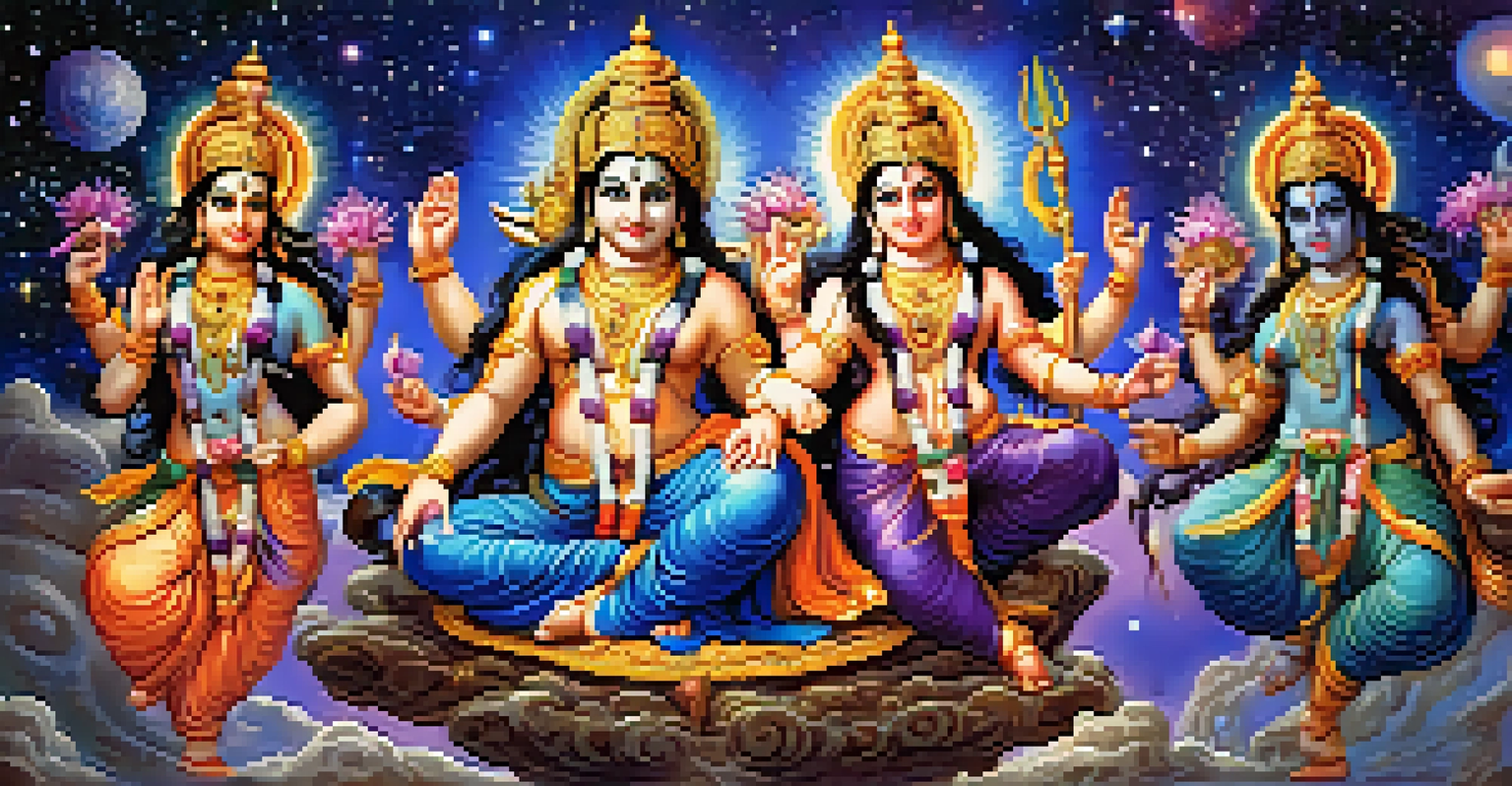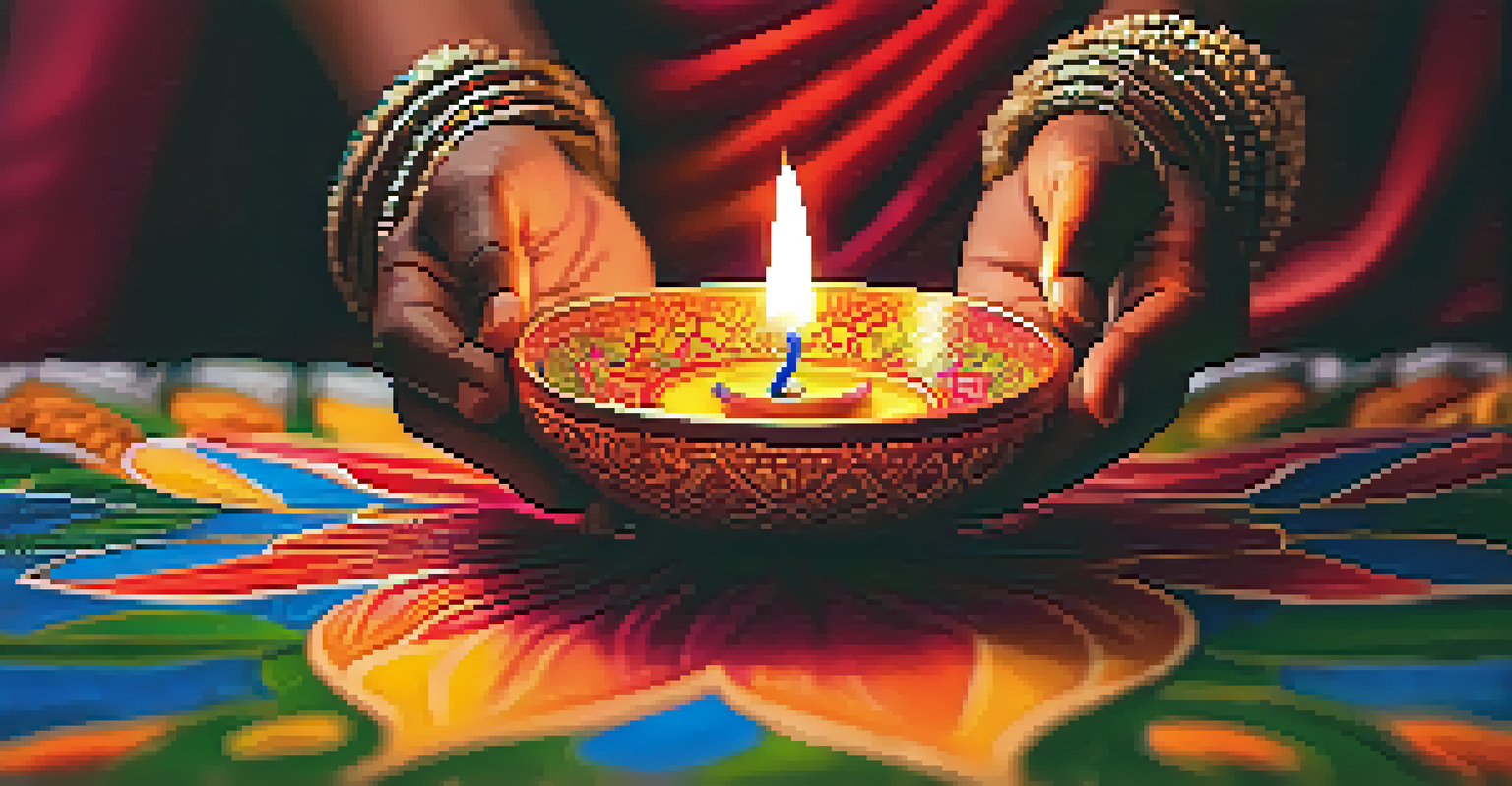The Universe in Hinduism: Deities and Cosmic Cycles Explained

Understanding the Cosmic Concept in Hinduism
In Hinduism, the universe is viewed as a vast, dynamic entity that operates in cycles. This cyclical nature reflects the belief in creation, preservation, and destruction, known as the Trimurti: Brahma the creator, Vishnu the preserver, and Shiva the destroyer. These deities symbolize the endless cycle of life, similar to the seasons that come and go, bringing renewal and change.
The universe is a manifestation of Brahman, the ultimate reality, and everything in it is interconnected.
The concept of cosmic cycles, or Yugas, is central to understanding the universe in Hindu thought. Each Yuga represents a distinct phase in the evolution of the world, with the current age, Kali Yuga, often described as one of decline and moral degradation. Just as a day progresses from dawn to dusk, these Yugas illustrate a grand narrative of rise and fall that resonates with the human experience.
This cyclical view encourages adherents to embrace the impermanence of life and recognize that every ending heralds a new beginning. It’s a reminder that challenges and hardships are temporary, much like the changing phases of the moon. By grasping this cosmic rhythm, individuals can find peace and purpose within the larger tapestry of existence.
The Role of Deities in the Cosmic Framework
Deities in Hinduism serve as vital players in the cosmic drama, embodying various aspects of existence and the universe. Each deity represents different forces of nature and human experience, functioning as both protectors and guides. For example, Saraswati, the goddess of wisdom, symbolizes knowledge and learning, helping humanity navigate the complexities of life.

Moreover, these deities are often depicted in rich stories and epics, such as the Ramayana and Mahabharata, which illustrate their roles in maintaining cosmic order. Just as a conductor guides an orchestra, these deities harmonize the various elements of the universe, ensuring that balance is preserved amidst chaos. Their narratives inspire devotion and offer insights into the human condition.
Cyclical Nature of the Universe
Hinduism views the universe as a dynamic entity operating in cycles of creation, preservation, and destruction, akin to the changing seasons.
The worship of these deities fosters a deep connection between the individual and the cosmos, allowing followers to tap into divine energy. Rituals, prayers, and festivals are ways to honor these deities, reinforcing the belief that the divine is present in every aspect of life. This relationship nurtures a sense of belonging and purpose, connecting personal struggles to the overarching cosmic order.
The Four Yugas: A Journey Through Time
The Hindu cosmic timeline is divided into four Yugas: Satya, Treta, Dvapara, and Kali. Each Yuga represents a different phase of spiritual evolution and moral standing, with Satya Yuga being a golden age of truth and righteousness. As we progress through the ages, the moral fabric of society gradually deteriorates, reflecting the cycle of human behavior.
In every act of creation, there is an act of destruction. This is the cosmic law of the universe.
In Treta Yuga, virtue begins to decline, but there remains a strong sense of justice and righteousness. The subsequent Dvapara Yuga witnesses further moral decay, as the distinction between right and wrong becomes increasingly blurred. This gradual decline illustrates a poignant truth: just as a river becomes muddied over time, so too does human consciousness wade through confusion and chaos.
Finally, we arrive at Kali Yuga, the current age, characterized by strife, discord, and a departure from spiritual values. However, this age also carries the promise of hope and renewal, suggesting that even in darkness, there is potential for light. Understanding these cycles helps believers recognize the importance of personal responsibility and the possibility of redemption, no matter the current circumstances.
The Cycle of Creation: From Nothingness to Existence
In Hindu cosmology, the universe undergoes a continuous cycle of creation, preservation, and dissolution. This cycle begins with the cosmic void, known as 'Shunya,' from which the universe emerges. Just as a seed contains the potential for a mighty tree, the universe's creation embodies infinite possibilities waiting to unfold.
Brahma, the creator god, is said to manifest the universe through his immense power, giving rise to all living beings and the cosmos itself. This act of creation is not merely a one-time event; it is a process that unfolds over vast periods of time, reflecting the patience and persistence of nature. Every creation cycle brings forth new forms and experiences, enriching the tapestry of life.
Role of Deities in Cosmic Order
Deities in Hinduism symbolize various aspects of existence, guiding individuals and maintaining cosmic balance through rich narratives and rituals.
At the end of each cycle, the universe undergoes dissolution, returning to its primordial state. This process mirrors natural phenomena, like the changing of seasons or the cycle of birth and death. It serves as a powerful reminder that endings are not final; they pave the way for new beginnings, encouraging believers to embrace change as an essential part of existence.
The Concept of Dharma in the Cosmic Order
Dharma, often translated as 'duty' or 'righteousness,' plays a crucial role in maintaining cosmic balance in Hinduism. Each individual has a unique Dharma, shaped by their circumstances, relationships, and societal roles. Just as a thread woven into a tapestry contributes to the overall design, fulfilling one's Dharma ensures the harmony of the universe.
Adhering to Dharma not only benefits the individual but also strengthens the collective fabric of society. It promotes ethical behavior and social responsibility, encouraging individuals to act in ways that uplift their community. The idea of Dharma underscores the interconnectedness of all beings, reminding us that our actions ripple through the cosmos.
Moreover, the pursuit of Dharma leads to spiritual growth and ultimate liberation, known as Moksha. By aligning with one's true purpose, individuals can transcend the cycles of birth and death, achieving unity with the divine. This journey of self-discovery and fulfillment reflects the broader cosmic principles that govern existence.
The Importance of Rituals and Worship
Rituals and worship in Hinduism serve as vital expressions of devotion and connection to the divine. These practices encompass a wide range of activities, from daily prayers to grand festivals, each designed to honor the deities and align oneself with cosmic principles. Just as a musician practices scales to master their craft, these rituals help devotees cultivate a deeper relationship with the universe.
In addition to fostering connection, rituals provide a sense of structure and community for practitioners. Festivals like Diwali and Navaratri bring people together, celebrating the triumph of light over darkness and good over evil. These shared experiences create bonds among individuals, reinforcing the idea that we are all part of a larger cosmic family.
Interconnectedness of All Beings
The belief in interconnectedness in Hinduism emphasizes that all beings are part of a single cosmic web, fostering empathy and responsibility toward one another.
Moreover, rituals serve as reminders of the cyclical nature of life. They mark significant moments, such as births, marriages, and transitions, celebrating the continuous flow of existence. By participating in these practices, individuals acknowledge their place in the universe and embrace the beauty of life’s ever-changing journey.
The Interconnectedness of All Beings in the Cosmos
In Hinduism, the belief in interconnectedness emphasizes that all beings are part of a single cosmic web. This idea is encapsulated in the concept of 'Brahman,' the ultimate reality that pervades everything. Just as threads in a spider's web are intricately woven together, all living beings exist in a relationship of mutual dependence and influence.
This interconnectedness fosters a sense of empathy and compassion towards others, recognizing that every action has consequences. The principle of 'Ahimsa,' or non-violence, encourages individuals to treat all living beings with respect and kindness. By understanding that hurting another is akin to harming oneself, followers are motivated to live harmoniously with nature and one another.

Ultimately, this holistic view inspires a deeper appreciation for the environment and the universe. It reminds individuals that their well-being is intertwined with the health of the planet and the cosmos. By nurturing this sense of connectedness, we can cultivate a more compassionate and sustainable world, reflecting the true essence of Hindu philosophy.